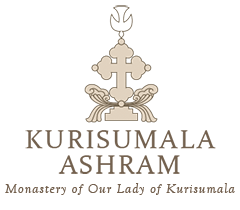
Origin and Growth
“Leave your country, your people and your father’s household and go to the land I’ll show you” (Gen. 12:1). The proximate reason for the establishment of Kurisumala Ashram was John Mahieu’s (later Francis Acharya) response to this divine call. Though a Belgium by birth, the seeds of his vocation, which culminated in the oblation of his life at Kurisumala as a true Indian, were sown by none other than the father of the nation, Mahatma Gandhi. This took place during the days of the round-table conference in London, where John was a student at that time.
After making profession at the Cistercian (Trappist) monastery in Scourmont, Belgium, he followed a persistent call to India and set foot in this “cradle of monasticism” in 1955. After an extensive ‘stay-and-study’ at major Indian Ashrams, he had a short stay with the founders of Saccidanandaj Ashram (Shantivanam) in Tiruchirappalli. Eventually, he accepted the invitation of Zacharias Mar Athanasios, the then Bishop of the Syro-Malankara Diocese of Tiruvalla, and officially established Kurisumala Ashram near Vagamon on March 21, 1958, in the company of Fr. Bede Griffiths, an English Benedictine monk, and a couple of aspirants.
Enveloped by the elements in the shadow of the cross, this small nucleus grew into a koinonia of fifteen in three years under the watchful eyes of Fr. Francis who was their father, mother, confidant and guru. Of the scenic beauty of Kurisumala’s surroundings, he wrote:
This joyous site of rocks and hills,
The sparkling jewels of the highlands of Kerala,
A land of grassy slopes with flowers of many hues,
With glades where fair trees dance in the wind…
These pioneers of Kurisumala Ashram bent their backs and shed the sweat of their brows and soon turned this beautiful but infertile tract of land into a veritable paradise of green pastures, flower gardens, and vegetable beds. Stone barriers were raised to protect crops and conserve soil, trees were planted, terraces built, dams constructed, the face of the earth was renewed… In the course of time, simple stone buildings were erected for the church, living quarters and guest-houses. A herd of cows was raised from scratch and soon a dairy farm was operational, and it served the dual purpose of providing a livelihood for the community and supporting the poor families nearby. Within ten years, this agricultural development and the establishment of a cattle-breeding center gave it an image of the Promised Land for many, a land flowing with milk and honey…
Immersed in the regular monastic milieu of prayer, work and spiritual reading, this small band of sadhakas, brahmacharis and sannyasis continued to cross milestones: Fr. Francis’ Indian citizenship, Fr. Bede’s departure to Shantivanam as its superior, Fr. Francis’ shashtiabdapurthi and his taking of the title of Acharya, introduction of the Bharatiya Pooja,… In 1998, the Ashram was incorporated into the Order of the Cistercians of Strict Observance (a world-wide contemplative order with its Generalate in Rome) with the status of an autonomous Abbey. The Tarrawarra Abbey in Australia ‘adopted’ Kurisumala as its daughter-house.
Fr. Francis Acharya, who was blessed as Abbot in 1999, passed away on January 31, 2002, and Fr. Yesudas Thelliyil was blessed as the second Abbot of Kurisumala on March 20, 2002.
An important moment of Kurisumala Ashram’s history—the 50th anniversary of foundation—was completed and celebrated on January 31st, 2008.
Having completed 75 years of age, with 12 years in the Abbatial ministry, Fr. Yesudas resigned. Fr. Ishanand was blessed as our third Abbot on April 7, 2014.
Trusting in the grace of God and the intercession of many here and above, especially that of Our Lady, we look with eyes of hope towards the future.
